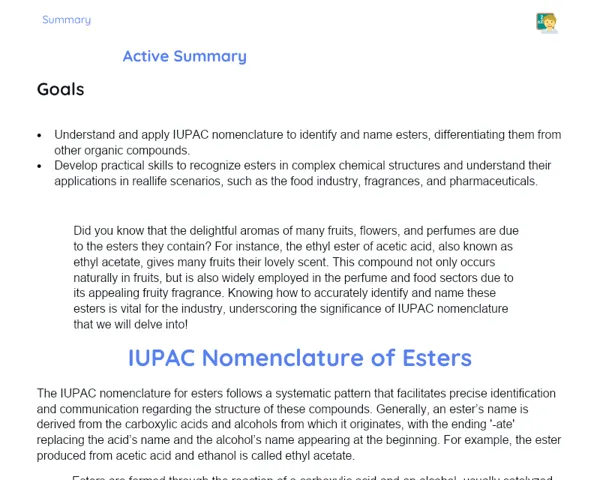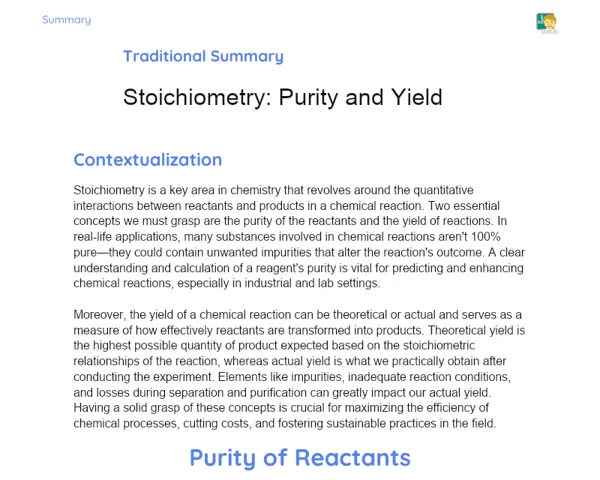Objectives
1. By the end of this lesson, you will be able to tackle problems involving the mixing of solutions with different solutes without triggering any chemical reactions, accurately calculating initial and final concentrations with confidence.
2. Develop practical skills to apply theoretical knowledge in real-world scenarios, enhancing your analytical and critical thinking abilities.
3. Strengthen your teamwork skills and learn to communicate your findings clearly and persuasively.
Contextualization
Did you know that the techniques for mixing solutions without chemical reactions are crucial not only in labs but also in industries like pharmaceuticals and food? For example, in the pharmaceutical sector, mixing different substances for drug production must be done in a manner that keeps the components stable and effective until consumption. This requires an in-depth understanding of solution properties and their interactions without undesirable reactions. Therefore, mastering how to calculate and prepare these mixtures is vital for innovation and safety in many everyday products.
Important Topics
Calculating Initial and Final Concentrations
Calculating initial and final concentrations is a key aspect of mixing solutions without invoking chemical reactions. This process entails determining the required quantities of solute and solvent to achieve the desired concentrations, ensuring the mixture remains physically compatible and safe. Knowing how to conduct these calculations is foundational for practical applications, such as the preparation of medicines and industrial solutions.
-
Initial Concentration: This refers to the quantity of solute present per unit volume of the solution prior to mixing.
-
Final Concentration: The amount of solute per unit volume of the solution after mixing, computed based on the law of conservation of mass.
-
Practical Importance: These calculations are vital for ensuring the efficacy and safety of industrial and laboratory processes, and for preventing unwanted reactions that could alter the desired properties of the mixture.
Physical and Chemical Properties of Solutes and Solvents
Understanding the physical and chemical properties of solutes and solvents is pivotal in predicting mixing behaviors. Factors like solubility, polarity, and reactivity influence whether a chemical reaction will take place, guiding the best practices to prepare solutions without undesirable reactions.
-
Solubility: The capacity of a solute to dissolve in a solvent, impacted by aspects such as polarity and temperature.
-
Polarity: Polar solvents dissolve polar solutes more effectively, while nonpolar solvents do the same for nonpolar solutes, which is crucial to avoid unexpected reactions.
-
Reactivity: Solutions with solutes that may undergo chemical reactions must be handled carefully to prevent harmful or dangerous reactions.
Mixing and Preparation Techniques
Choosing the right mixing and preparation method is vital for ensuring the uniformity of the mixture and the effectiveness of the procedure. Techniques such as stirring, heating, and controlled dilution are commonly employed to prepare solutions without prompting chemical reactions, keeping in mind the physical and chemical properties of the components.
-
Stirring: Essential for promoting the complete dissolution of the solute in the solvent, thus expediting the solution preparation.
-
Heating: This can enhance the solubility of many solutes but needs to be managed carefully to prevent unwanted reactions.
-
Controlled Dilution: This method allows for adjusting the final concentration of the solution without significantly altering the mixture's properties, which is critical in both pharmaceutical and laboratory contexts.
Key Terms
-
Initial Concentration: Amount of solute per unit volume of the solution before mixing.
-
Final Concentration: Amount of solute per unit volume of the solution after mixing.
-
Solubility: The extent to which a solute can dissolve in a solvent under specified conditions.
For Reflection
-
How could changes in temperature influence the solubility of a solute, and thereby, the preparation of a solution without a chemical reaction?
-
Why is it crucial to consider the physical and chemical traits of solutes and solvents when preparing solutions in an industrial framework?
-
In what ways can the knowledge of concentration calculations and solution properties be applied in everyday life, beyond the confines of the laboratory?
Important Conclusions
-
We have gained mastery in calculating initial and final concentrations, fundamental for the safe preparation of solutions without any unintended chemical reactions.
-
We explored the physical and chemical characteristics of solutes and solvents, comprehending how solubility, polarity, and reactivity affect mixtures.
-
We learned various techniques for preparing solutions, including stirring, heating, and controlled dilution, which are essential for practical applications in both laboratories and industries.
To Exercise Knowledge
Set up a 'home laboratory' with common kitchen ingredients to create simple solutions. Outline the preparation process, calculate the initial and final concentrations, and discuss how the properties of the ingredients influenced their mixing.
Challenge
Chemical Bartender Challenge: Craft a 'chemical cocktail' using solutions of varying concentrations. Design an original recipe, calculating the required quantities to ensure that the solutes do not react. Present your creation with scientific justification for the choices made!
Study Tips
-
Regularly review concentration and solubility calculations through everyday examples, such as preparing lemonade or diluting concentrated juice.
-
Watch educational videos on solution preparation methods, observing how professionals manage the solubility and reactivity of different substances.
-
Create mind maps or visual summaries that connect the properties of solutes and solvents with solution preparation techniques, aiding in the understanding and retention of these concepts.



